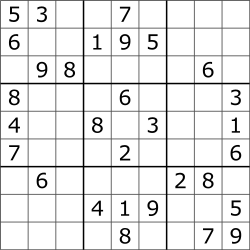Sudoku (/suːˈdoʊkuː, -ˈdɒk-, sə-/; Japanese: 数独, romanized: sūdoku, lit. 'digit-single'; originally called Number Place)[1] is a logic-based,[2][3] combinatorial[4] number-placement puzzle. In classic Sudoku, the objective is to fill a 9 × 9 grid with digits so that each column, each row, and each of the nine 3 × 3 subgrids that compose the grid (also called "boxes", "blocks", or "regions") contains all of the digits from 1 to 9. The puzzle setter provides a partially completed grid, which for a well-posed puzzle has a single solution.
French newspapers featured similar puzzles in the 19th century, and the modern form of the puzzle first appeared in 1979 puzzle books by Dell Magazines under the name Number Place.[5] However, the puzzle type only began to gain widespread popularity in 1986 when it was published by the Japanese puzzle company Nikoli under the name Sudoku, meaning "single number".[6] In newspapers outside of Japan, it first appeared in The Conway Daily Sun (New Hampshire) in September 2004, and then The Times (London) in November 2004, both of which were thanks to the efforts of the Hong Kong judge Wayne Gould, who devised a computer program to rapidly produce unique puzzles.
- ^ Grossman, Lev (Mar 11, 2013). "The Answer Men". Time. New York. Archived from the original on 2013-03-01. Retrieved 2013-03-04.(registration required)
- ^ Arnoldy, Ben. "Sudoku Strategies". The Christian Science Monitor.
- ^ Schaschek, Sarah (Mar 22, 2006). "Sudoku champ's surprise victory". The Prague Post. Archived from the original on 2006-08-13. Retrieved 2009-02-18.
- ^ Gradwohl, Ronen; Naor, Moni; Pinkas, Benny; Rothblum, Guy N. (2007). "Cryptographic and Physical Zero-Knowledge Proof Systems for Solutions of Sudoku Puzzles". In Crescenzi, Pierluigi; Prencipe, Giuseppe; Pucci, Geppino (eds.). Fun with Algorithms, 4th International Conference, FUN 2007, Castiglioncello, Italy, June 3-5, 2007, Proceedings. Lecture Notes in Computer Science. Vol. 4475. Springer. pp. 166–182. doi:10.1007/978-3-540-72914-3_16. ISBN 978-3-540-72913-6.
- ^ Cite error: The named reference
Smithwas invoked but never defined (see the help page). - ^ Hayes, Brian (2006). "Unwed Numbers". American Scientist. 94 (1): 12–15. doi:10.1511/2006.57.3475.

